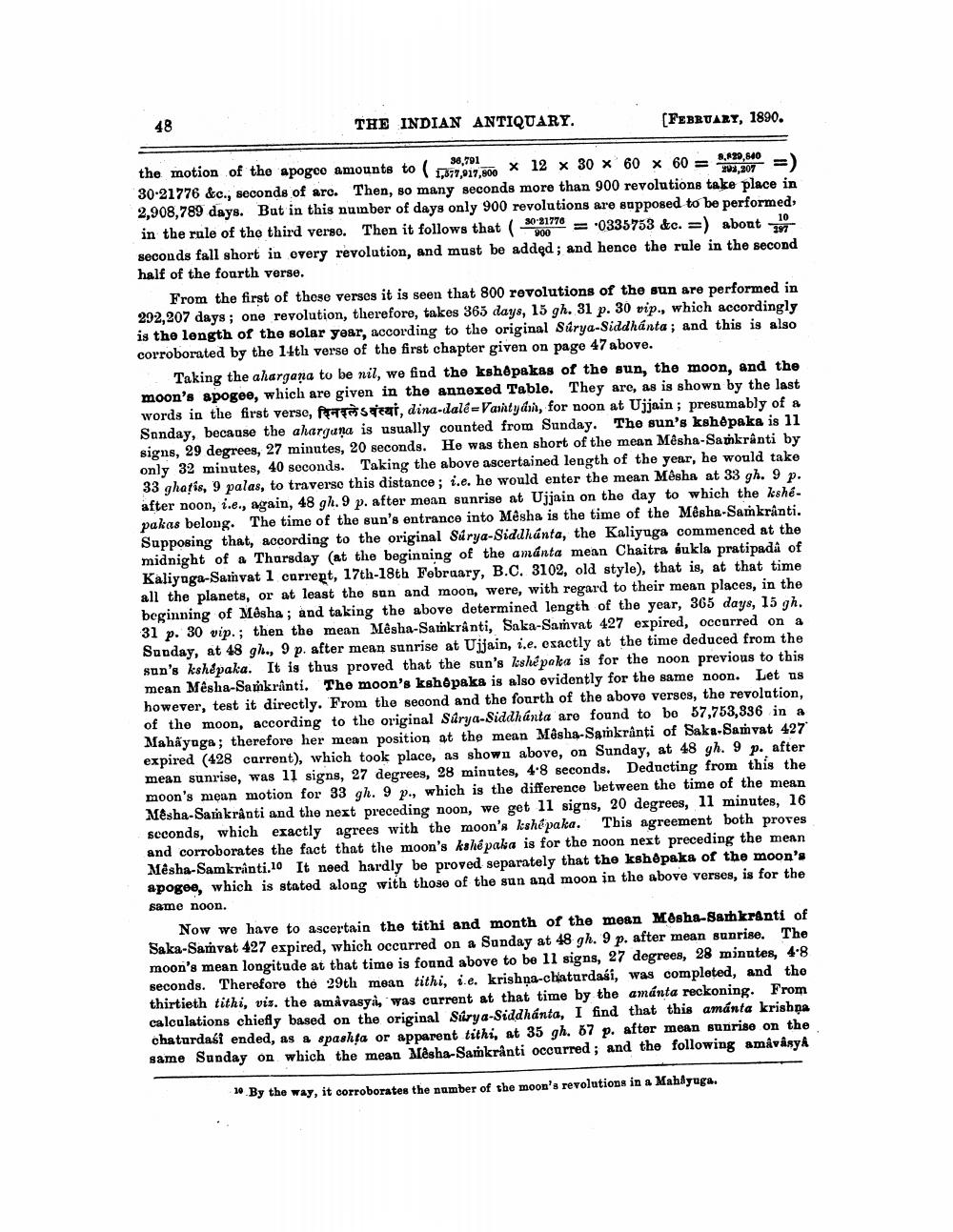________________
48
THE INDIAN ANTIQUARY.
[FEBRUARY, 1890.
=)
the motion of the apogee amounts to (1,377,917,800 x 12 x 30 x 60 x 60 = 30-21776 &c., seconds of arc. Then, so many seconds more than 900 revolutions take place in 2,908,789 days. But in this number of days only 900 revolutions are supposed to be performed, in the rule of the third verso. =0335753 &c. =) about 97 Then it follows that ( seconds fall short in every revolution, and must be added; and hence the rule in the second half of the fourth verse.
30-21776 900
8,829,640 202,207
From the first of these verses it is seen that 800 revolutions of the sun are performed in 292,207 days; one revolution, therefore, takes 365 days, 15 gh. 31 p. 30 vip., which accordingly is the length of the solar year, according to the original Surya-Siddhanta; and this is also corroborated by the 14th verse of the first chapter given on page 47 above.
Taking the ahargana to be nil, we find the kshêpakas of the sun, the moon, and the moon's apogee, which are given in the annexed Table. They are, as is shown by the last words in the first verse, seat, dina-dale-Vantyám, for noon at Ujjain; presumably of a Sunday, because the alargana is usually counted from Sunday. The sun's kshêpaka is 11 signs, 29 degrees, 27 minutes, 20 seconds. He was then short of the mean Mêsha-Sankranti by only 32 minutes, 40 seconds. Taking the above ascertained length of the year, he would take 33 ghatis, 9 palas, to traverse this distance; i.e. he would enter the mean Mêsha at 33 gh. 9 p. after noon, i.e., again, 48 gh. 9 p. after mean sunrise at Ujjain on the day to which the kshépakas belong. The time of the sun's entrance into Mêsha is the time of the Mêsha-Samkrânti. Supposing that, according to the original Súrya-Siddhánta, the Kaliyuga commenced at the midnight of a Thursday (at the beginning of the amanta mean Chaitra sukla pratipada of Kaliyuga-Samvat 1 current, 17th-18th February, B.C. 3102, old style), that is, at that time all the planets, or at least the sun and moon, were, with regard to their mean places, in the beginning of Mêsha; and taking the above determined length of the year, 365 days, 15 gh. 31 p. 30 vip.; then the mean Mêsha-Samkrânti, Saka-Samvat 427 expired, occurred on a Sunday, at 48 gh., 9 p. after mean sunrise at Ujjain, i.e. exactly at the time deduced from the sun's kshépaka. It is thus proved that the sun's kshépaka is for the noon previous to this mean Mêsha-Samkrinti. The moon's kshêpaka is also evidently for the same noon. Let us however, test it directly. From the second and the fourth of the above verses, the revolution, of the moon, according to the original Surya-Siddhanta are found to be 57,753,336 in a Mahayuga; therefore her mean position at the mean Mêsha-Sankranti of Saka-Samvat 427 expired (428 current), which took place, as shown above, on Sunday, at 48 gh. 9 p. after mean sunrise, was 11 signs, 27 degrees, 28 minutes, 4-8 seconds. Deducting from this the moon's mean motion for 33 gh. 9 p., which is the difference between the time of the mean Mêsha-Sankranti and the next preceding noon, we get 11 signs, 20 degrees, 11 minutes, 16 seconds, which exactly agrees with the moon's kshépaka. This agreement both proves and corroborates the fact that the moon's kshépaka is for the noon next preceding the mean Mêsha-Samkranti.10 It need hardly be proved separately that the kshêpaka of the moon's apogee, which is stated along with those of the sun and moon in the above verses, is for the
same noon.
Now we have to ascertain the tithi and month of the mean Mêsha-Sankranti of Saka-Samvat 427 expired, which occurred on a Sunday at 48 gh. 9 p. after mean sunrise. The moon's mean longitude at that time is found above to be 11 signs, 27 degrees, 28 minutes, 4.8 seconds. Therefore the 29th mean tithi, i.e. krishna-chaturdasi, was completed, and the thirtieth tithi, viz. the amavasya, was current at that time by the amúnta reckoning. From calculations chiefly based on the original Surya-Siddhánta, I find that this amánta krishna chaturdasi ended, as a spashta or apparent tithi, at 35 gh. 57 p. after mean sunrise on the same Sunday on which the mean Mêsha-Samkrânti occurred; and the following amâvâsyA
10 By the way, it corroborates the number of the moon's revolutions in a Mahayuga.




